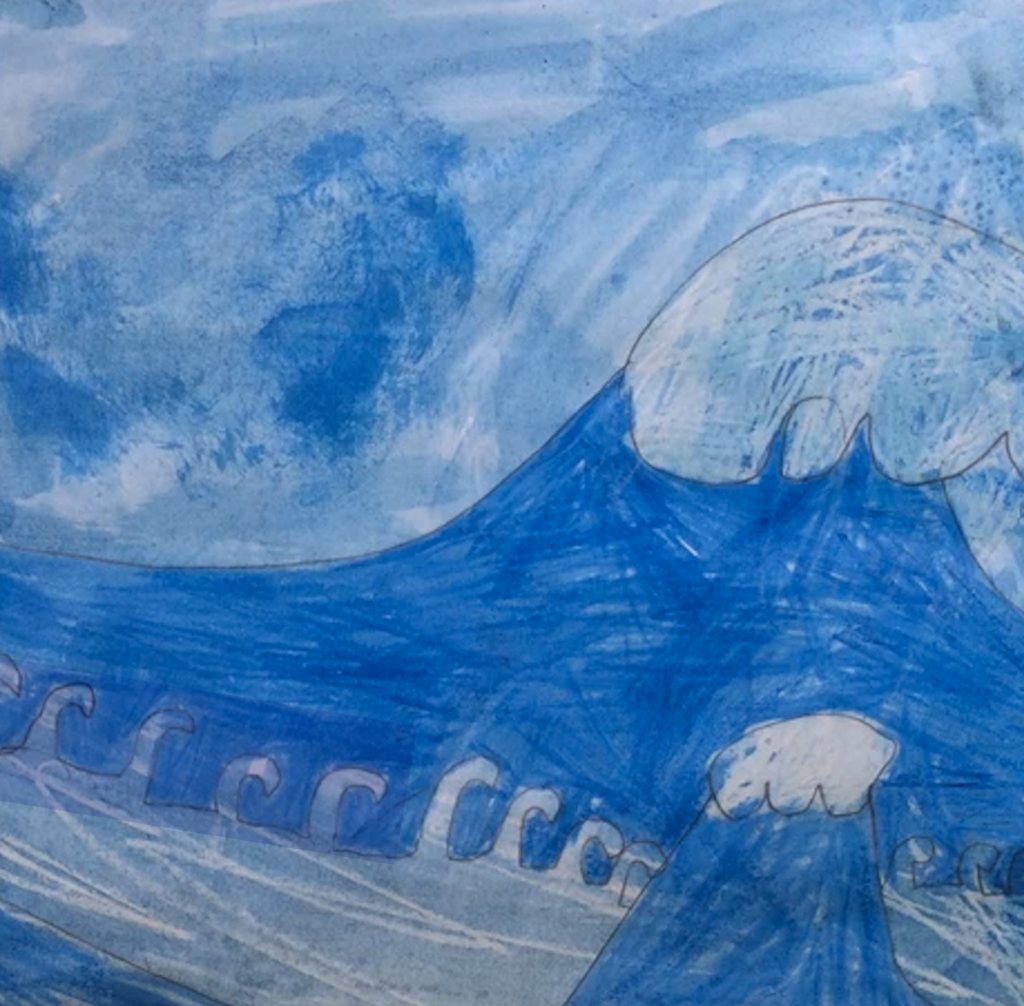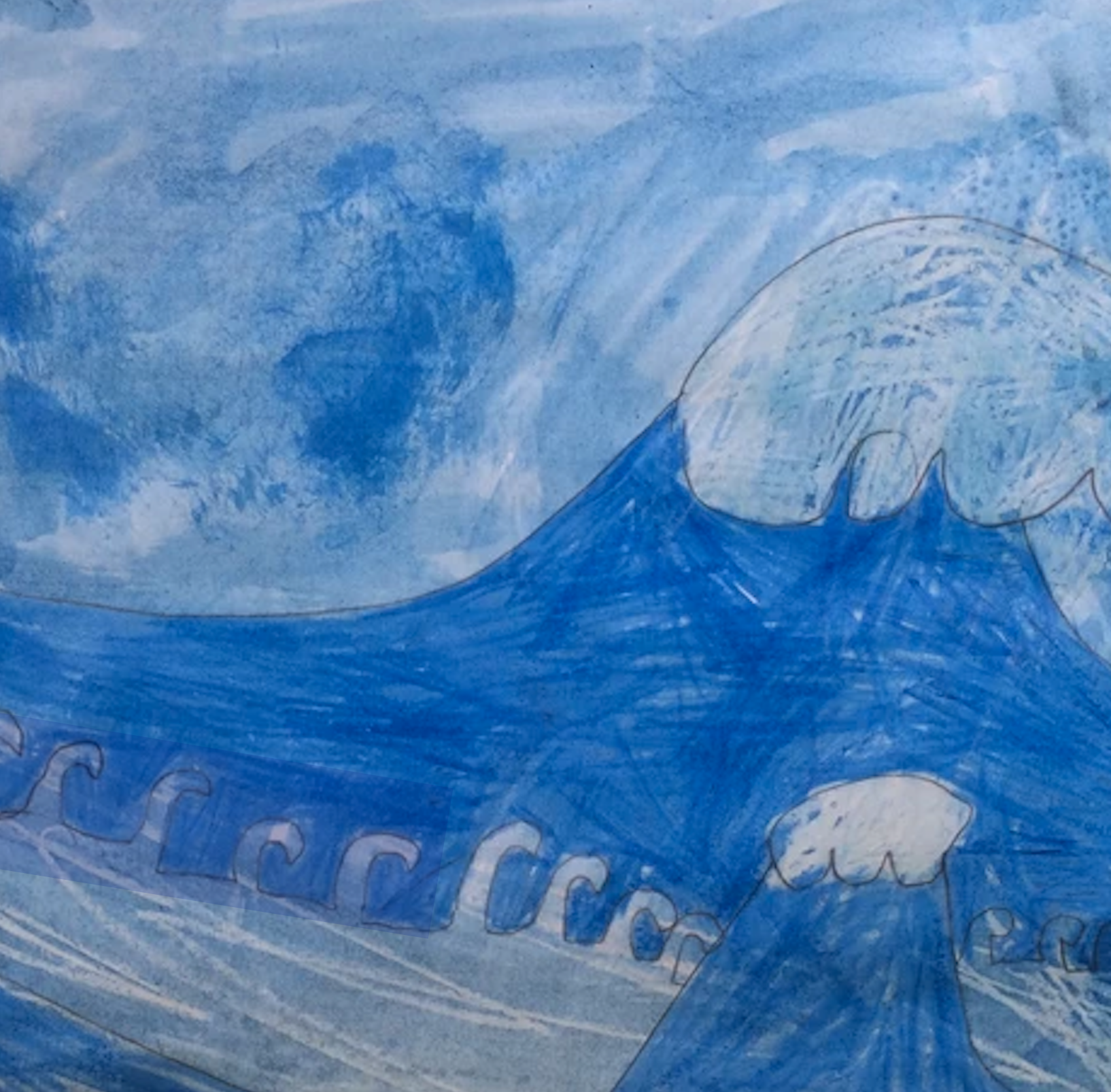Let’s dive into the world of Katsushika Hokusai and his mesmerising woodblock print, “The Great Wave off Kanagawa.” With its towering wave and majestic Mount Fuji, this masterpiece has become a symbol of Japanese art and creativity.
In today’s Hokusai-inspired art lesson crafted just for kids, we will embark on a hands-on activity of paper crafting, exploring the beauty and power of the Great Wave. So, gather your little artists for this super simple and interactive paper craft inspired by Hokusai’s awe-inspiring painting.
Discovering Hokusai and “The Great Wave”
Who is Hokusai?
Katsushika Hokusai, a legendary figure in Japanese art, lived a long life as vibrant and dynamic as his brushstrokes. Born in 1760 in Edo (now Tokyo) during the Edo period, Hokusai became a master ukiyo-e artist, specialising in woodblock prints.
With boundless creativity and an insatiable desire for exploration, he produced an astonishing array of artwork across various genres, including landscapes, portraits, and nature studies. Hokusai’s immense talent and unconventional style challenged traditional norms, earning him the nickname “Old Man Mad About Painting.”
His enduring legacy lies in his ability to capture the essence of Japan’s beauty and culture, forever imprinting his genius on art history.

Fun Facts about Hokusai
- Hokusai claimed that he started drawing at the age of six and believed he didn’t become truly skilled until he turned 80!
- Hokusai had a deep love for cats and often included them in his artworks, making them a recurring theme in his prints.
- The Great Wave has been parodied and recreated in various forms, from LEGO sculptures to emoji art.
- Hokusai’s art studio was often filled with eccentric objects like shells, fossils, and unusual plants to inspire his creativity.
- The Great Wave off Kanagawa was initially a part of a series of prints, but it became so popular that it overshadowed the others.
- Hokusai was known for his quirky personality and earned the nickname “old man mad about painting”
- The Great Wave has become a beloved symbol of Japan, and you can find it on everything from t-shirts to postage stamps.
Diving Into The Elements of “The Great Wave”
- The Wave: The towering wave in Hokusai’s Great Wave represents the immense power and unpredictability of nature. It symbolises challenges and obstacles we face in life, reminding us to stay resilient and brave.
- Mount Fuji: Mount Fuji, with its serene presence, represents stability and strength. It acts as a contrast to the dynamic wave, symbolising the enduring spirit and beauty amidst chaos.
- Boats: The boats in the artwork represent human beings facing the overwhelming force of nature. They showcase our vulnerability and perseverance in the face of adversity.
- Colour and Lines: Hokusai’s use of vibrant colours and bold lines adds energy and movement to the composition. The strong contrasts and dynamic curves create a sense of drama, capturing the intensity of the wave and drawing our attention to its power.|
- Composition: Overall, the elements in The Great Wave seamlessly work together to create a visually striking and harmonious composition. The wave, Mount Fuji, and the boats are carefully arranged to lead our eyes around the artwork, evoking a sense of motion and guiding our emotions as we experience the awe-inspiring scene.
- Symbolic Meaning: The artwork as a whole represents the human struggle against the forces of nature. It reminds us of our connection with the world around us and the need to find balance and resilience in the face of life’s challenges.
Enhancing this Hokusai Art Lesson
Have conversations with your students about “The Great Wave” and discover how this incredible artwork has made a huge splash in the art world. Explore together its deep meaning, the awe it inspires, and how it continues to inspire artists of all ages with its powerful waves and majestic Mount Fuji!
Check out this fun book on Hokusai called “He Saw The World In A Wave” to get started. It’s a great intro for young kids.
Art Project: Creating a Hokusai-Inspired Paper Wave Artwork

Materials You Need:
- Blue paper or cardboard for the base
- Pre-cut light blue and dark blue paper strips (prepared by the teacher)
- Scissors
- Glue or tape
- Popsicle sticks (optional, for the boat’s sail)
- Markers or coloured pencils (optional, for decorating the boat)
1: Introduction
- Show the children an image of Hokusai’s Great Wave and briefly explain its significance as a famous artwork.
- Discuss the concept of waves and the movement and energy they represent.
2: Preparation
- Provide each child with a blue piece of paper or cardboard as the base for their artwork.
- Place pre-cut light blue and dark blue paper strips on each table, ready for use.
3: Creating the Waves
- Instruct the children to glue or tape the light and dark blue paper strips onto their blue base, arranging them in a wave-like pattern.
- Encourage them to alternate between light and dark blue strips to create a dynamic effect.
4: Making the Boat
- Demonstrate how to fold a simple origami boat or provide pre-cut boat shapes for the children.
- If using origami, guide them through the steps of folding and securing the boat.
- If using pre-cut shapes, instruct them to decorate the boat with markers or colored pencils.
5: Finishing Touches
- Once the boats are ready, help the children attach their boats to the waves using glue or tape.
- For added creativity, provide popsicle sticks for the boat’s sail, attaching them to the boat using tape or glue.

Materials Needed:
- White drawing paper
- Pencil
- Wax crayons (blue and any other colors you may wish to include)
- Blue watery paint (watercolor or tempera)
- Paintbrush
- Water container
- Paper towels or cloth for blotting
1: Sketch the Great Wave
- Begin by lightly sketching the outline of Hokusai’s Great Wave using a pencil.
- Use the reference image as a guide.
2: Trace with Wax Crayon
- Once finished with the sketch, trace over the pencil lines with blue wax crayon.
- Press firmly to ensure the wax creates a barrier on the paper.
3: Prepare the paint
- Dilute blue watery paint in a container.
- The more water you add, the lighter the shade of blue will be when applied.
4: Paint Over the Drawing
- Brush over the entire paper with the diluted blue paint.
- Be careful not to disturb the wax crayon lines.
- The paint will not adhere to the wax, leaving those areas white. Where there’s no wax, it will turn blue.
5: Allow to Dry
- Let the painting dry completely.
- You can speed up the drying process with a hairdryer if needed.
- Enjoy the finished masterpiece!
Wrapping up:
- Allow time for the children to share their completed artworks with the class, discussing their waves and boats.
- Encourage them to express their thoughts and feelings about the process and the artwork they created.
- Discuss the connection between their own paper project and Hokusai’s Great Wave, emphasising the creativity and inspiration that art can bring.
We’ve embarked on a fantastic artistic journey, exploring the mesmerising world of Katsushika Hokusai and his iconic Great Wave. Through our own paper craft inspired by this masterpiece, we have discovered the power of waves and the enduring impact of Hokusai’s artwork. Each unique creation showcases the creativity and imagination of our young artists. Remember, art has the ability to transport us, inspire us, and ignite our own artistic spirits. If you liked this lesson or tried it out yourself, leave a comment and let me know how it went!
